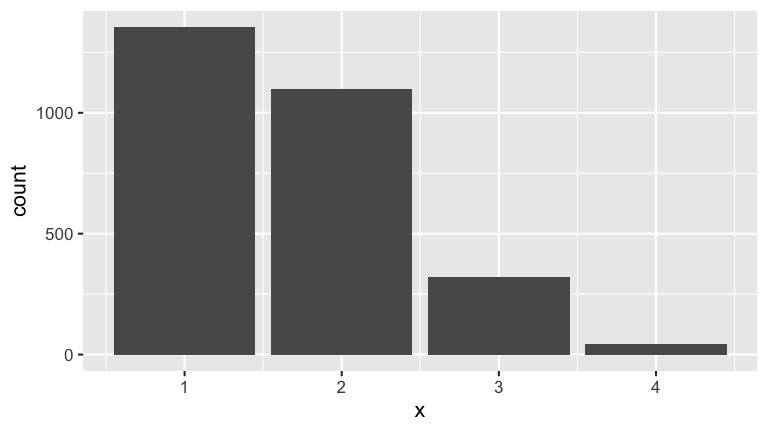18 Discrete: joint & conditional models
READING
For more on this topic, read B & H Chapter 7.1 - 7.2.
18.1 Discussion
EXAMPLE 1: marginal models
Roll a die six times. Let
\[\begin{split} X & = \text{ # of 4's in the 6 rolls} \\ Y & = \text{ # of 4's in the first 2 rolls} \\ \end{split}\]
Then the marginal models of \(X\) and \(Y\) are
\[p_X(x) = P(X = x) \;\; \text{ and } \;\; p_Y(y) = P(Y = y)\]
In tables:
| \(x\) | 0 | 1 | 2 | … | 6 | Total |
|---|---|---|---|---|---|---|
| \(p_X(x)\) | \(p_X(0)\) | \(p_X(1)\) | \(p_X(2)\) | … | \(p_X(6)\) | 1 |
| \ |
| \(y\) | 0 | 1 | 2 | Total |
|---|---|---|---|---|
| \(p_Y(y)\) | \(p_Y(0)\) | \(p_Y(1)\) | \(p_Y(2)\) | 1 |
In pictures:

EXAMPLE 2: Joint behavior
\[p_{X,Y}(x,y) = P((X = x) \cap (Y = y))\]
In a table:
| \(p_{X,Y}(x,y)\) | 0 | \(y\) 1 | 2 | Total |
|---|---|---|---|---|
| 0 | \(p_{X,Y}(0,0)\) | \(p_{X,Y}(0,1)\) | \(p_{X,Y}(0,2)\) | \(p_X(0)\) |
| 1 | \(p_{X,Y}(1,0)\) | \(p_{X,Y}(1,1)\) | \(p_{X,Y}(1,2)\) | \(p_X(1)\) |
| 2 | \(p_{X,Y}(2,0)\) | \(p_{X,Y}(2,1)\) | \(p_{X,Y}(2,2)\) | \(p_X(2)\) |
| 3 | \(p_{X,Y}(3,0)\) | \(p_{X,Y}(3,1)\) | \(p_{X,Y}(3,2)\) | \(p_X(3)\) |
| 4 | \(p_{X,Y}(4,0)\) | \(p_{X,Y}(4,1)\) | \(p_{X,Y}(4,2)\) | \(p_X(4)\) |
| 5 | \(p_{X,Y}(5,0)\) | \(p_{X,Y}(5,1)\) | \(p_{X,Y}(5,2)\) | \(p_X(5)\) |
| 6 | \(p_{X,Y}(6,0)\) | \(p_{X,Y}(6,1)\) | \(p_{X,Y}(6,2)\) | \(p_X(6)\) |
| Total | \(p_{Y}(0)\) | \(p_{Y}(1)\) | \(p_{Y}(2)\) | 1 |
In pictures:
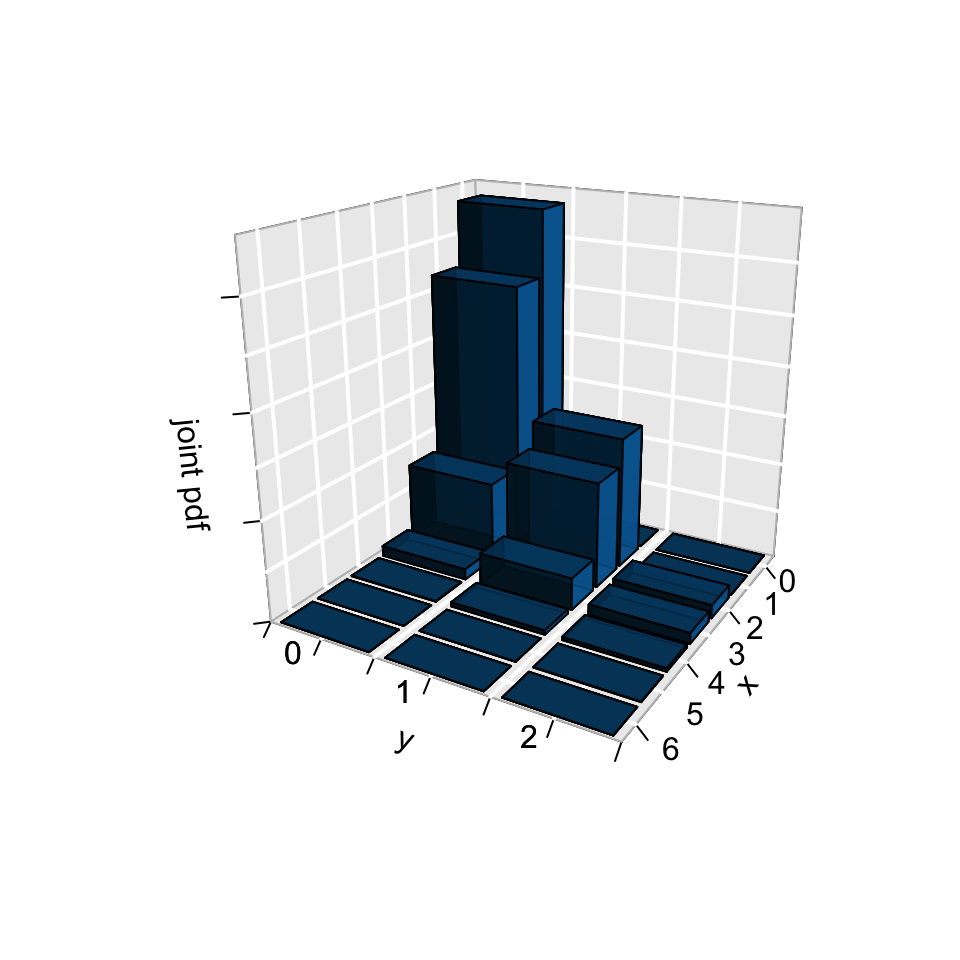
Joint models - Discrete RVs
The simultaneous behavior of \(X\) and \(Y\) is described by their joint pmf \[p_{X,Y}(x,y) = P(\{X=x\} \cap \{Y=y\}) = P(X=x, Y=y) \;\; \text{(shorthand)}\] where
- \(p_{X,Y}(x,y) \ge 0\) for all \(x,y\)
- \(\sum_x\sum_y p_{X,Y}(x,y) = 1\)
- Given the joint behavior of \(X\) & \(Y\), we can find their marginal behaviors using the Law of Total Probability!: \[\begin{split} p_X(x) & = \sum_{all \; y} p_{X,Y}(x,y) \\ p_Y(y) & = \sum_{all \; x} p_{X,Y}(x,y) \\ \end{split}\]
EXAMPLE: Conditional behavior
I tell you that when I rolled the die 6 times, there was one 4 in the first two rolls. The spirit of the conditional pdf of \(X\), the number of 4’s in all 6 rolls, given this information is illustrated below:
\[p_{X|(Y=1)}(x|(y=1)) = P(X=x \; | \; Y=1)\]
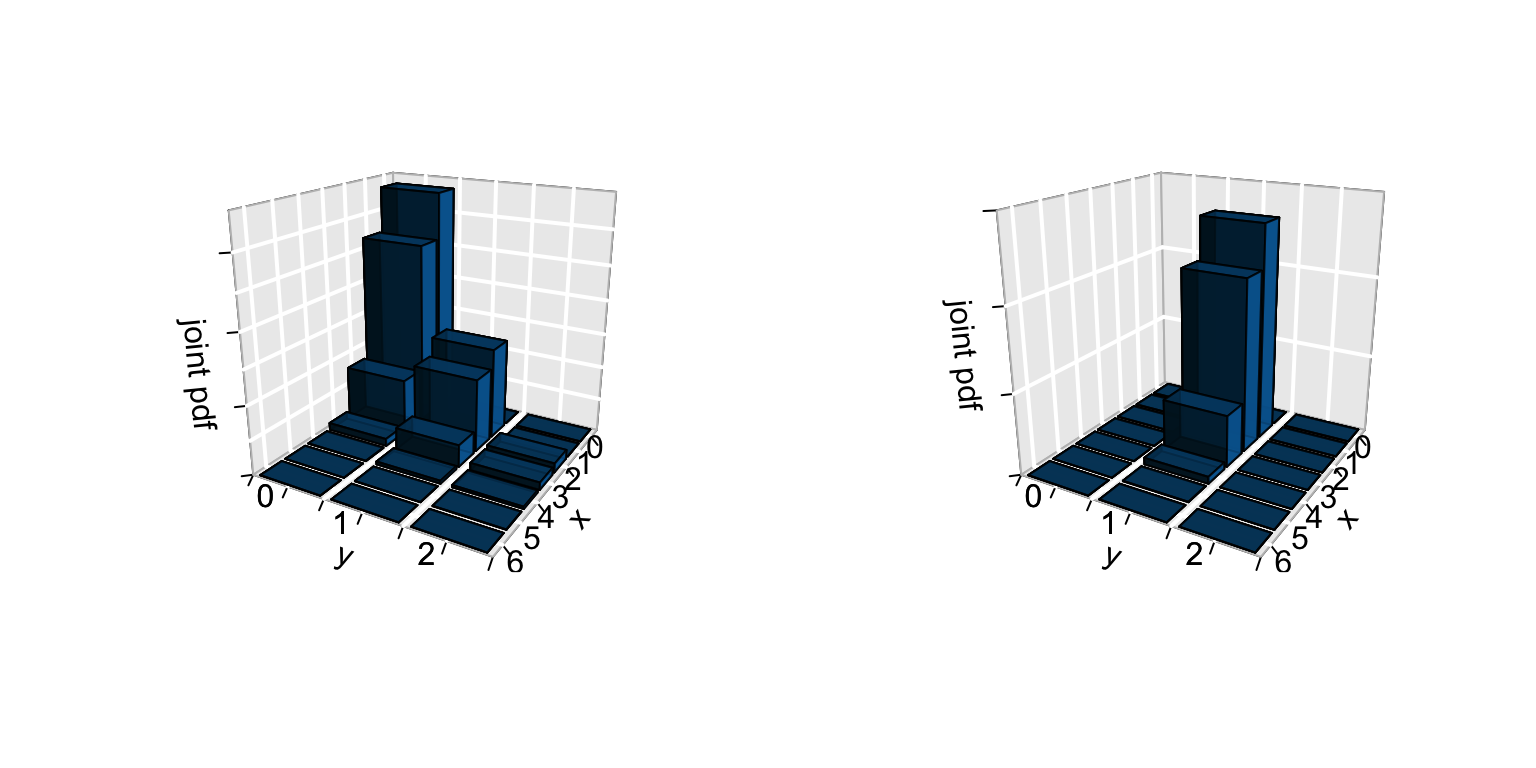
Conditional models - Discrete RVs
The conditional behavior of \(Y\) given that we observe \(X=x\) is described by the conditional pmf \[p_{Y|X=x}(y|x) = P(Y=y | X=x)\] where
- \(p_{Y|X=x}(y|x) \ge 0\) for all \(x,y\)
- \(\sum_y p_{Y|X=x}(y|x) = 1\)
- Given the joint & marginal behaviors of \(X\) & \(Y\), we can find their conditional behaviors: \[\begin{split} p_{Y|X=x}(y|x) = P(Y=y | X=x) & = \frac{P(Y=y,X=x) }{P(X=x)} = \frac{p_{X,Y}(x,y)}{p_X(x)} \end{split}\]
\(X\) and \(Y\) are independent if and only if \[\begin{split} p_{Y|X=x}(y|x) & = p_Y(y) \\ p_{X,Y}(x,y) & = p_X(x)p_Y(y) \\ \end{split}\]
NOTE: These statements are equivalent. You only need to check one of them!
18.2 Exercises
In the exercises below, you’ll explore joint and conditional models in the following setting. Roll a die six times. Let \[\begin{split} X & = \text{ # of 4's in the 6 rolls} \\ Y & = \text{ # of 4's in the first 2 rolls} \\ \end{split}\]
To build intuition, you’ll also simulate this experiment 10,000 times and record the observed \(X\) and \(Y\) for each experiment. There are many more efficient ways to do this, but the following might be more easy to follow:
# Load packages
library(dplyr)
library(janitor)
library(ggplot2)
# Set up the die
die <- c(1:6)
# Set the seed
set.seed(354)
# Simulate the experiment 10000 times
results <- data.frame(
roll_1 = sample(die, size = 10000, replace = TRUE),
roll_2 = sample(die, size = 10000, replace = TRUE),
roll_3 = sample(die, size = 10000, replace = TRUE),
roll_4 = sample(die, size = 10000, replace = TRUE),
roll_5 = sample(die, size = 10000, replace = TRUE),
roll_6 = sample(die, size = 10000, replace = TRUE)) %>%
mutate(x = (roll_1 == 4) + (roll_2 == 4) + (roll_3 == 4) + (roll_4 == 4) + (roll_5 == 4) + (roll_6 == 4)) %>%
mutate(y = (roll_1 == 4) + (roll_2 == 4))Check out the first 6 experiments. Confirm your understanding of what’s being recorded:
head(results, 6)
## roll_1 roll_2 roll_3 roll_4 roll_5 roll_6 x y
## 1 6 3 5 5 2 4 1 0
## 2 3 2 1 1 5 1 0 0
## 3 5 5 1 3 1 2 0 0
## 4 3 3 4 1 1 5 1 0
## 5 1 5 1 1 1 4 1 0
## 6 4 3 6 3 1 4 2 1
- Marginal models: Simulation
Examine the marginal behavior of \(X\) alone and \(Y\) alone:
# Table summaries
results %>%
tabyl(x)
results %>%
tabyl(y)
# Graphical summaries
library(ggplot2)
ggplot(results, aes(x = x)) +
stat_count()
ggplot(results, aes(x = y)) +
stat_count()
Solution
# Table summaries
results %>%
tabyl(x)
## x n percent
## 0 3419 0.3419
## 1 3982 0.3982
## 2 1992 0.1992
## 3 519 0.0519
## 4 86 0.0086
## 5 2 0.0002
results %>%
tabyl(y)
## y n percent
## 0 6916 0.6916
## 1 2814 0.2814
## 2 270 0.0270
# Graphical summaries
library(ggplot2)
ggplot(results, aes(x = x)) +
stat_count()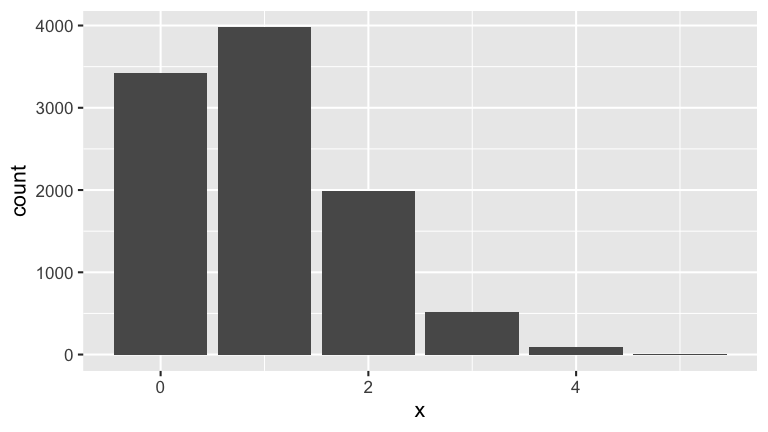
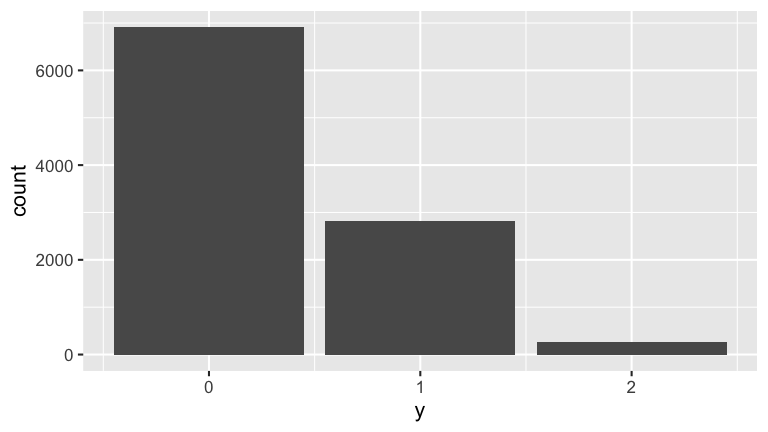
Joint model: Simulation
Examine the joint behavior of \(X\) and \(Y\). Be sure to note that the grand table sum is 1 that the row & column sums correspond to the marginal models of \(X\) and \(Y\)!# Table summaries results %>% tabyl(x, y) %>% adorn_percentages("all") %>% adorn_totals(c("row", "col")) # Graphical summary ggplot(results, aes(x = x, fill = as.factor(y))) + stat_count(position = position_dodge(preserve = "single")) # 3D plot summary library(plot3D) x <- c(0:6) y <- c(0:2) p_xy <- function(x,y){choose(2,y)*choose(4,x-y)*(1/6)^x*(5/6)^(6-x)} z <- outer(x, y, p_xy) hist3D (x = x, y = y, z = z, bty = "g", phi = 20, theta = 120, xlab = "x", ylab = "y", zlab = "p(x,y)", main = "", col = "#0072B2", border = "black", shade = 0.8, ticktype = "detailed", space = 0.15, d = 2, cex.axis = 1e-9, alpha=0.8, zlim=c(0,0.35)) text3D(x = rep(7, 3), y = 0:2, z = rep(0, 3), labels = c("0","1","2"), add = TRUE, adj = 1) text3D(x = 0:6, y = rep(3,7), z = rep(0, 7), labels = c("0","1","2","3","4","5","6"), add = TRUE, adj = 2.5)
Solution
# Table summaries results %>% tabyl(x, y) %>% adorn_percentages("all") %>% adorn_totals(c("row", "col")) ## x 0 1 2 Total ## 0 0.3419 0.0000 0.0000 0.3419 ## 1 0.2627 0.1355 0.0000 0.3982 ## 2 0.0764 0.1097 0.0131 0.1992 ## 3 0.0098 0.0319 0.0102 0.0519 ## 4 0.0008 0.0043 0.0035 0.0086 ## 5 0.0000 0.0000 0.0002 0.0002 ## Total 0.6916 0.2814 0.0270 1.0000 # Graphical summary ggplot(results, aes(x = x, fill = as.factor(y))) + stat_count(position = position_dodge(preserve = "single"))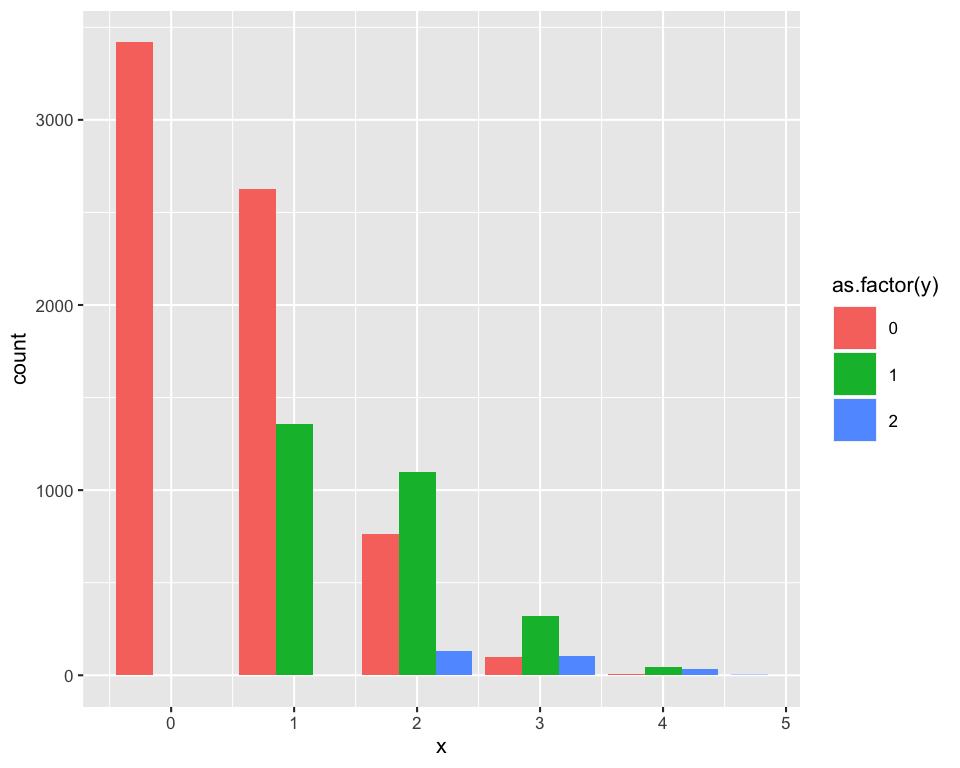
# 3D plot summary library(plot3D) x <- c(0:6) y <- c(0:2) p_xy <- function(x,y){choose(2,y)*choose(4,x-y)*(1/6)^x*(5/6)^(6-x)} z <- outer(x, y, p_xy) hist3D (x = x, y = y, z = z, bty = "g", phi = 20, theta = 120, xlab = "x", ylab = "y", zlab = "p(x,y)", main = "", col = "#0072B2", border = "black", shade = 0.8, ticktype = "detailed", space = 0.15, d = 2, cex.axis = 1e-9, alpha=0.8, zlim=c(0,0.35)) text3D(x = rep(7, 3), y = 0:2, z = rep(0, 3), labels = c("0","1","2"), add = TRUE, adj = 1) text3D(x = 0:6, y = rep(3,7), z = rep(0, 7), labels = c("0","1","2","3","4","5","6"), add = TRUE, adj = 2.5)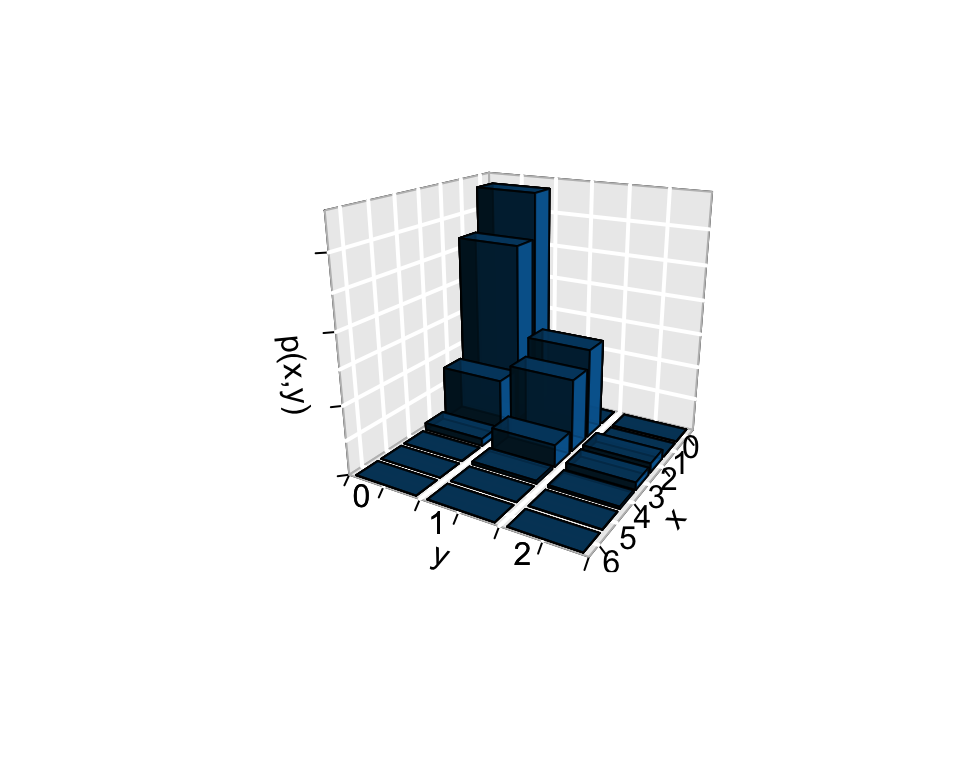
Conditional model: simulation
Suppose I tell you \(Y = 1\). Examine the conditional behavior of \(X\) given this information. Note that within the world where \(Y = 1\), the model of \(X\) is valid – the conditional pmf sums to 1.# Restrict the sample space y_1 <- results %>% filter(y == 1) # Table summary y_1 %>% tabyl(x) # Graphical summary ggplot(y_1, aes(x = x)) + stat_count()
Solution
- Marginal models: Math
a. Convince yourself that \(X \sim Bin(6,1/6)\) and \(Y \sim Bin(2,1/6)\). Thus \[\begin{split} p_{X}(x) & = \left( \begin{array}{c} 6 \\x \end{array} \right)\frac{1}{6}^x \frac{5}{6}^{6-x} \;\; \text{ for } x \in \{0,1,2,3,4,5,6\} \\ p_{Y}(y) & = \left( \begin{array}{c} 2 \\y \end{array} \right)\frac{1}{6}^y \frac{5}{6}^{2-y} \;\; \text{ for } y \in \{0,1,2\} \\ \end{split}\]
b. For peace of mind, confirm at least one calculation in each of the following tables. The Monte Carlo simulation results from exercise 1 should be very similar!
c. Confirm that $E(X) = 1$.| \(x\) | 0 | 1 | 2 | 3 | 4 | 5 | 6 | Total |
|---|---|---|---|---|---|---|---|---|
| \(p_X(x)\) | 0.33490 | 0.40188 | 0.20094 | 0.05358 | 0.00804 | 0.00064 | 0.00002 | 1 |
| \(y\) | 0 | 1 | 2 | Total |
|---|---|---|---|---|
| \(p_Y(y)\) | 0.69444 | 0.27778 | 0.02778 | 1 |
Solution
Yes. Both \(X\) and \(Y\) are the number of successes in a fixed number of independent trials, each trial having the same probability of success.
\(p_X(0) = \left( \begin{array}{c} 6 \\ 0\end{array} \right)\frac{1}{6}^0 \frac{5}{6}^{6-0} = 0.3349\)
\(X \sim Bin(6,1/6)\), thus \(E(X) = 6*1/6 = 1\)
- Joint model: Math
Build a formula for the joint pmf of \(X\) and \(Y\). Be careful with the support! HINT: The answer is revealed in exercise 6 if you get stuck. \[\begin{split} p_{X,Y}(x,y) & = P(X=x,Y=y) = ??? \end{split}\]
For peace of mind, confirm at least one calculation in the following table. The Monte Carlo simulation results from exercise 2 should be very similar!
\(p_{X,Y}(x,y)\) 0 \(y\) 1 2 Total 0 0.334898 0 0 0.33490 1 0.267917 0.133960 0 0.40188 2 0.080376 0.107167 0.013396 0.20094 3 0.010717 0.032150 0.010717 0.05358 4 0.000536 0.004287 0.003215 0.00804 5 0 0.000214 0.000429 0.00064 6 0 0 0.000021 0.00002 Total 0.69444 0.2778 0.02778 1
Solution
For \(y \in \{0,1,2\}, x \in \{y,...,y+4\}\), \[\begin{split} p_{X,Y}(x,y) & = P(y \text{ 4's in first 2 }, x-y \text{ in last 4}) \\ & = \left( \begin{array}{c} 2 \\y \end{array} \right) \frac{1}{6}^y \frac{5}{6}^{2-y} \cdot \left( \begin{array}{c} 4 \\x-y \end{array} \right) \frac{1}{6}^{x-y} \frac{5}{6}^{4-x+y} \\ & = \left( \begin{array}{c} 2 \\y \end{array} \right) \left( \begin{array}{c} 4 \\x-y \end{array} \right) \frac{1}{6}^x \frac{5}{6}^{6-x}\\ \end{split}\]
Conditional model: math
Above you built the marginal and joint models of \(X\) and \(Y\):\[\begin{split} p_{X}(x) & = \left( \begin{array}{c} 6 \\x \end{array} \right)\frac{1}{6}^x \frac{5}{6}^{6-x} \;\; \text{ for } x \in \{0,1,2,3,4,5,6\} \\ p_{Y}(y) & = \left( \begin{array}{c} 2 \\y \end{array} \right)\frac{1}{6}^y \frac{5}{6}^{2-y} \;\; \text{ for } y \in \{0,1,2\} \\ p_{X,Y}(x,y) & = \left( \begin{array}{c} 2 \\y \end{array} \right) \left( \begin{array}{c} 4 \\x-y \end{array} \right) \left(\frac{1}{6}\right)^x \left(\frac{5}{6}\right)^{6-x} \;\; \text{ for } y \in \{0,1,2\}, x \in \{y,...,y+4\} \\ \end{split}\]
Suppose I tell you that I rolled a die 6 times and there was one 4 in the first two rolls (\(Y = 1\)). Build the conditional pmf of \(X\), the number of 4’s in all 6 rolls, given this information: \[p_{X|(Y=1)}(x|(y=1)) = P(X=x | Y=1) = ???\]
For peace of mind, using your formula from part a, confirm at least one of the calculations in the following table:
\(x\) 1 2 3 4 5 Total \(p_{X|(Y=1)}(x|(y=1))\) 0.482 0.386 0.116 0.015 0.001 1 Further, re-examine the table of the joint pmf \(p_{X,Y}(x,y)\). Confirm that \(p_{X|(Y=1)}((x=1)|(y=1)) = 0.482\) using the joint table as opposed to the formula from part a.
Calculate \(E(X|(Y=1))\) and compare this to \(E(X) = 1\).
Solution
.
\[\begin{split} p_{X|(Y=1)}(x|(y=1)) & = \frac{p_{X,Y}(x,1)}{p_Y(1)} \\ & = \frac{\left( \begin{array}{c} 2 \\ 1 \end{array} \right) \left( \begin{array}{c} 4 \\x - 1 \end{array} \right) \left(\frac{1}{6}\right)^x \left(\frac{5}{6}\right)^{6-x}}{\left( \begin{array}{c} 2 \\1 \end{array} \right)\frac{1}{6}^1 \frac{5}{6}^{2-1} } \\ & = \frac{\left( \begin{array}{c} 4 \\x - 1 \end{array} \right) \left(\frac{1}{6}\right)^x \left(\frac{5}{6}\right)^{6-x}}{\frac{1}{6} \frac{5}{6} } \\ & = \left( \begin{array}{c} 4 \\x - 1 \end{array} \right) \left(\frac{1}{6}\right)^{x-1} \left(\frac{5}{6}\right)^{5-x} \\ \end{split}\]
.
\[\begin{split} p_{X|(Y=1)}((x=1)|(y=1)) & = \left( \begin{array}{c} 4 \\ 1 - 1 \end{array} \right) \left(\frac{1}{6}\right)^{1-1} \left(\frac{5}{6}\right)^{5-1} \\ & = \left(\frac{5}{6}\right)^{4} \\ & \approx 0.482 \\ \end{split}\]\(0.133960/0.2778 \approx 0.482\)
\(E(X|(Y=1)) = 1*.482 + 2*.386 + 3*0.116 + 4*0.015 + 5*0.001 = 1.667\)
Knowing that we already got 1 4 in the first 2 rolls, we expect more 4’s overall (relative to when we don’t know what happened in the first 2 rolls).
- General conditional model
- In general, suppose I tell you that I rolled a die 6 times and there were \(y\) 4’s in the first two rolls. Calculate the conditional pmf of \(X\) given this information. (Does this make intuitive sense now that you see the formula?!?) \[p_{X|(Y=y)}(x|y) = P(X=x | Y=y) = ???\]
- CHALLENGE (give it a try): Prove that this is a valid conditional pmf.
- CHALLENGE (give it a try): Provide a general formula for \(E(X|(Y=y))\).
Solution
For \(x \in \{y,...,y+4\}\),
\[\begin{split} p_{X|(Y=y)}(x|y) & = \frac{p_{X,Y}(x,y)}{p_Y(y)} \\ & = \frac{\left( \begin{array}{c} 2 \\ y \end{array} \right) \left( \begin{array}{c} 4 \\ x - y \end{array} \right) \left(\frac{1}{6}\right)^x \left(\frac{5}{6}\right)^{6-x}}{\left( \begin{array}{c} 2 \\ y \end{array} \right)\frac{1}{6}^y \frac{5}{6}^{2-y} } \\ & = \frac{\left( \begin{array}{c} 4 \\x - y \end{array} \right) \left(\frac{1}{6}\right)^x \left(\frac{5}{6}\right)^{6-x}}{\frac{1}{6}^y \frac{5}{6}^{2-y} } \\ & = \left( \begin{array}{c} 4 \\ x - y \end{array} \right) \left(\frac{1}{6}\right)^{x-y} \left(\frac{5}{6}\right)^{4-(x-y)} \\ \end{split}\].
\[\begin{split} \sum_{x = y}^{y+4}p_{X|(Y=y)}(x|y) & = \sum_{x = y}^{y+4}\left( \begin{array}{c} 4 \\ x - y \end{array} \right) \left(\frac{1}{6}\right)^{x-y} \left(\frac{5}{6}\right)^{4-(x-y)} \\ & = \sum_{z = 0}^{4}\left( \begin{array}{c} 4 \\ z \end{array} \right) \left(\frac{1}{6}\right)^{z} \left(\frac{5}{6}\right)^{4-z} \;\;\; \text{(letting $z = x-y$)} \\ & = \sum_{z = 0}^{4} \text{pmf of a Bin(4, 1/6)} \\ & = 1 \\ \end{split}\]FUN!
\[\begin{split} E(X|(Y=y)) & = \sum_{x = y}^{y+4}x*p_{X|(Y=y)}(x|y) & = \sum_{x = y}^{y+4}x*\left( \begin{array}{c} 4 \\ x - y \end{array} \right) \left(\frac{1}{6}\right)^{x-y} \left(\frac{5}{6}\right)^{4-(x-y)} \\ & = \sum_{z = 0}^{4}(z+y)*\left( \begin{array}{c} 4 \\ z \end{array} \right) \left(\frac{1}{6}\right)^{z} \left(\frac{5}{6}\right)^{4-z} \;\;\; \text{(letting $z = x-y$)} \\ & = \sum_{z = 0}^{4} (z + y) * (\text{pmf of a Bin(4, 1/6)}) \\ & = \sum_{z = 0}^{4} z * (\text{pmf of a Bin(4, 1/6)}) + y \sum_{z = 0}^{4} (\text{pmf of a Bin(4, 1/6)}) \\ & = E(\text{a Bin(4, 1/6) RV}) + y*1 \\ & = 4*1/6 + y \\ & = 2/3 + y \\ \end{split}\]
- Independence
- In the dice experiment, are \(X\) and \(Y\) independent? Provide proof.
- Consider an apartment with 2 student roommates. Let \(X\) be the number of these students that are taking at least 1 MSCS class and \(Y\) be the number that like pizza. Based on the following table, are \(X\) and \(Y\) independent?
| \(p_{X,Y}(x,y)\) | 0 | \(y\) 1 | 2 | Total |
|---|---|---|---|---|
| 0 | 0.0075 | 0.0675 | 0.6750 | 0.75 |
| 1 | 0.0020 | 0.0180 | 0.1800 | 0.20 |
| 2 | 0.0005 | 0.0045 | 0.0450 | 0.05 |
| Total | 0.0100 | 0.09 | 0.90 | 1 |
Solution
No. \(p_{X|Y}(x|y) \ne p_X(x)\). Knowing what happens in the first 2 rolls (\(Y\)) tells us something about what happens overall (\(X\)).
- Yes. Every joint entry is a product of the marginals, \(p(x,y) = p(x)p(y)\).
